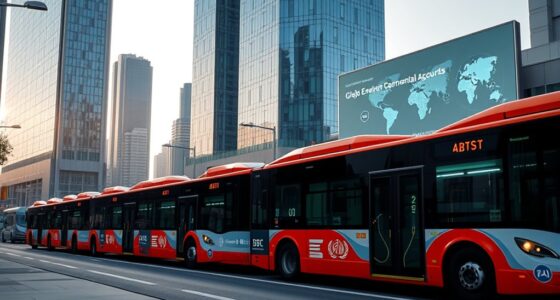In the US, you can get up to a $7,500 federal tax credit when buying a new electric VW Bus, plus additional state rebates, lower registration fees, and perks like HOV lane access, which lower your overall costs. In the EU, various countries offer purchase subsidies, tax reductions, and fee discounts to make the switch more affordable. These incentives, along with extra benefits like free charging, help you save, and if you keep exploring, you’ll discover how to maximize these advantages.
Key Takeaways
- The US offers up to $7,500 federal tax credits, reducing the purchase cost of new EVs like the VW Bus, with additional state incentives.
- EU countries provide purchase subsidies, tax reductions, and registration fee discounts, making electric VW Buses more affordable across member states.
- Both regions offer perks such as free charging, HOV lane access, and tax exemptions, lowering overall ownership costs.
- Awareness of these incentives allows consumers to maximize savings and benefits when buying an electric VW Bus.
- Incentives support environmental goals by making EV adoption easier, promoting sustainable transportation and reducing emissions.

Are you wondering how to make switching to an electric vehicle more affordable? One of the most effective ways is to take advantage of the various incentives and tax credits offered by governments in the US and the EU. These policies are designed to encourage more people to choose electric vehicles (EVs), and they can considerably reduce your upfront costs. Understanding how government policies work can help you maximize your consumer benefits, making it easier and more affordable to own an electric VW Bus or any other EV.
Discover how US and EU incentives can make owning an electric VW Bus more affordable and accessible.
In the United States, federal government policies provide substantial incentives for EV buyers. The federal tax credit can be worth up to $7,500, directly reducing the amount of taxes you owe. This incentive is available for new electric vehicles that meet specific criteria, including battery size and manufacturer sales caps. Many states also offer additional perks like rebates, reduced registration fees, or access to carpool lanes. These consumer benefits work together to lower the overall cost of ownership, making electric vehicles more accessible for a broader audience.
Similarly, in the European Union, government policies are heavily geared toward promoting sustainable transportation. The EU and individual member states offer a variety of incentives, including direct purchase subsidies, tax reductions, and registration fee discounts. Countries like Germany, France, and the Netherlands have established generous programs that can cover a significant portion of an EV’s purchase price. These policies are designed to not only reduce emissions but also make the transition to electric vehicles more appealing financially for consumers. By taking advantage of these incentives, you can enjoy substantial savings on your new VW Bus, easing the transition to greener transportation.
Both the US and EU policies aim to create consumer benefits that extend beyond initial savings. Many programs also include benefits like free or discounted charging, access to HOV lanes, and exemptions from certain taxes or fees. These perks further lower your total cost of ownership and enhance your driving experience. Knowing about these policies helps you plan your purchase better and guarantees you don’t miss out on available incentives.
Additionally, understanding the benefits of gorse plants for bees can inspire eco-friendly choices that support biodiversity and pollinator health, aligning with sustainable transportation goals. Ultimately, government policies in the US and EU are tailored to make EV ownership more attractive and affordable. They serve as powerful tools to reduce the financial barriers that might otherwise discourage you from making the switch. By staying informed about these incentives and how they work, you can maximize your consumer benefits, save money, and enjoy the many advantages of driving a new electric VW Bus. This proactive approach ensures you’re getting the best deal possible while contributing to a cleaner environment.
Frequently Asked Questions
How Do I Qualify for EV Incentives in My Local Area?
To qualify for EV incentives in your area, start by checking your local government’s requirements. You may need a valid vehicle registration and proof of purchase. Many incentives require you to install a charging station at your home or use public charging stations. Make sure your electric vehicle meets all eligibility criteria, and keep documentation handy to simplify the application process. Contact local agencies for specific details.
Are There Differences in Incentives Between States or Regions?
Ever wondered if your location makes a difference? Yes, state variations and regional programs can substantially impact the incentives you receive. Some areas offer hefty rebates, while others have minimal perks. You might be missing out if you don’t check what’s available locally. Incentives can vary widely, so explore your state’s programs to maximize your savings and guarantee you get the best deal on your electric VW bus.
Can I Combine Multiple Incentives for a Better Deal?
You can often stack incentives to get a better deal, but it depends on incentive limitations established by programs. Some incentives allow stacking, while others restrict you to only one benefit. Always check specific program rules, as combining multiple incentives can maximize your savings, but be aware of any restrictions to avoid losing out on potential benefits. Research local regulations to ensure you’re maximizing your electric vehicle purchase.
How Long Do EV Tax Credits and Incentives Last?
You wonder how long EV tax credits and incentives last. These benefits typically depend on government policies, which may change annually. While charging infrastructure improvements and battery recycling programs boost EV adoption, incentives might be phased out once targets are met or budgets run out. Stay informed about local policies, as these incentives can vary and sometimes expire unexpectedly, affecting your EV purchase plans.
Do Incentives Apply to Used Electric Vehicles?
Many believe used electric vehicles (EVs) don’t qualify for incentives, but that’s not always true. In the US, some federal and state programs now include used EVs, especially if they meet specific requirements like battery recycling standards and charging infrastructure compatibility. It’s worth checking local policies, as incentives can vary and may help offset costs when buying a used EV, making sustainable transportation more accessible for you.
Conclusion
Now that you know the details of EV incentives and tax credits, it’s time to take action. By leveraging these lucrative local and international incentives, you can markedly save on your electric VW bus purchase. Don’t delay—dive into discounts, deductions, and drives that deliver dollars back to you. With the right research and resources, you’ll soon be cruising comfortably, cost-effectively, and confidently in your eco-friendly electric VW bus. The future’s for the taking—so start steering your savings today!









